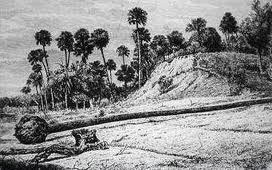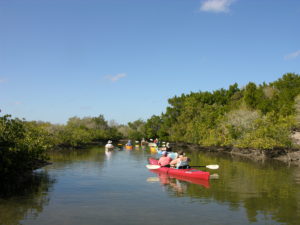 Canaveral National Seashore Kayak and Canoe trip
Canaveral National Seashore Kayak and Canoe trip
Group size: 1 – 24 people
Trip time: 3 – 6 hours (several options)
Skill level: Beginner – Expert
Cost
Most guided tours are $50 per person. (includes boat, paddle, vest, shuttling and your guide)
Using your Own Boat – $40. (many paddlers with their own boats like to join us to learn more about the history, archaeology and natural history of these rivers).
Dates
Join a scheduled tour (see tour calendar ), or suggest one. Find a free date on the calendar and suggest the trip of your choice. If there are no conflicts, we’ll post it!
OR
Schedule a private tour. Use contact form, email us at riverguide2000@yahoo.com or call (386-454-0611)
Location
Check the River Locator Map or Click the link below for a local map and then use zoom and panning arrows to explore the area. (Note: the marker is NOT our meeting place, but a nearby landmark.
Local Map Description
Description
This is one of the most interesting and diverse areas on the Adventure Outpost “Launch Menu”. With a fantastic variety of historical, archaeological and natural features, tours in the CNS are a non-stop learning experience. There are many possibilities for customizing your trip by adding some biking, hiking and driving elements to paddling adventure.
On this trip, we paddle the quiet lagoons of one of Florida’s finest parks. Extensive dunes and a maze of salt marshes, island hammocks and mangrove lagoons are home to nearly 1,045 plant species and 310 birds, not to mention a fine array of mammals, insects and (my favorites) reptiles.
Canaveral National Seashore has more than its share of outstanding and unique natural features. Perhaps the most noteworthy is it’s extensive pristine beach, which stretches for nearly 24 miles. The only high-rise building you’ll see here is NASA’s massive Vehicle Assembly Building (with more open space inside than any other building in the world), but even this architectural behemoth is a mere speck on the horizon.
For wildlife viewing and nature study, you’ll do best on the backside of the dunes and into the park’s extensive marshes and mangrove lagoons.
Wild Spices – If you’re going to treat yourself to some wild cuisine, there’s no reason it should be bland. There’s no rule that says wild food has to be mild food. Salt is probably the most popular (and necessary) flavoring in the world. Thankfully, it can be found in abundance in Canaveral Nat’l Seashore, as well as other coastal wetlands. The best source is saltwort and glasswort. These two succulent plants grow abundantly at the waters edge, often forming dense, knee-high thickets. Toss a few leaves and stems into your wild salad or sandwich, or cook it up with wild vegetables. Another local source for salt is cord grass. To survive in this harsh, salty environment, cord grass exudes excess salts from microscopic pores on the leaf surface. The tiny, glistening crystals can be seen on the leaf surface. Run a leaf blade between your fingers and you’ll be amazed at how much salt comes off – finger lickin’ good! Other wild flavorings that can be obtained from local plants range from hot and peppery to sweet. Others don’t fall into any specific category and are best described in terms ranging from “tasty” or “not exactly tasty” to “edible in a pinch” and “better than shoe leather”. Of course some are (yes, I’ll admit it) “disgusting”. Be sure to use reliable guides to identify plants and determine edibility.
 Archaeology
Archaeology
Within the bounds of this amazing preserve, there are over 100 registered archaeological sites.
Many shell middens and burial sites remain as silent reminders of thousands of years of native occupation of these low, coastal lagoons. One local site (not in the park) discovered in 1982, known as Windover, has proven to be one of the most significant archaeological sites in the country. Among the remains of over 40 sets of human remains, some dating back 8,000 years, researchers discovered some intact brain tissue.
Another, more obvious site, that is in the park is Turtle Mound. This 35 foot high Indian mound (50 feet when first excavated in the 1800’s) is composed of millions of sea shells, discarded as dinner scraps by Timucuan Indians during the period from about 800 to 1400 A.D. This massive shell mound stood as the highest landmark on Florida’s east coast for hundreds of years before Europeans arrived. In the early 1600’s, the Indian village of Surruque was located here.
History
During the Civil War, this quiet lagoon took on great importance as a port for importing and exporting goods for the Confederacy. All regular ports were blockaded, so blockade runners made this a regular port of call. Arriving shipments were brought through a small canal to Indian River and from there, a short overland wagon ride brought them to the headwaters of the St. Johns River.
On this exploration, we pass the ghost town of Eldora, a 19th century community which once boasted a population approaching 200. Like so many other early settlements, nature dealt a crippling blow to the citrus trees which were a mainstay of Eldora’s economy. In addition, when the Intra-coastal waterway was dug, it routed boat traffic to Mosquito lagoons western shore, opposite Eldora’s scenic little bluff on the eastern barrier island. The communities decline was slow, but finally in the 1960’s and ’70’s the last residents moved away.
Wildlife
In the open waters, crossing the lagoon toward the mangrove islands, we often see bottle-nosed dolphins rolling in the surf. Water birds including terns, gulls, egrets, herons, osprey, cormorants and eagles are all common. Birding is good during the migrations, especially in the fall.
 As we enter the lagoons and winding passages between islands, we find ourselves in the world of mangroves. Four varieties of mangroves flank our watery trail as we skim between the islands. Raccoons, can often be seen grubbing around for crustaceans and bivalves among the large “meadows” and saltpans of saltwort and glasswort. On larger islands, oaks, bay, palm and nakedwood trees dominate the over story, while a fantastic variety of shrubs and herbaceous plants cover the forest floor. A number of species reach the northern extent of their range in this park.
As we enter the lagoons and winding passages between islands, we find ourselves in the world of mangroves. Four varieties of mangroves flank our watery trail as we skim between the islands. Raccoons, can often be seen grubbing around for crustaceans and bivalves among the large “meadows” and saltpans of saltwort and glasswort. On larger islands, oaks, bay, palm and nakedwood trees dominate the over story, while a fantastic variety of shrubs and herbaceous plants cover the forest floor. A number of species reach the northern extent of their range in this park.
Difficulty
On warm days, this minimally shaded area can be uncomfortably warm. There’s also the possibility of strong breezes, so watch the weather before you go. Watch the tides. Even though the tide range is minimal in this sequestered lagoon, the shallow areas get barely passable around some of the islands if you don’t time your paddle accordingly.
